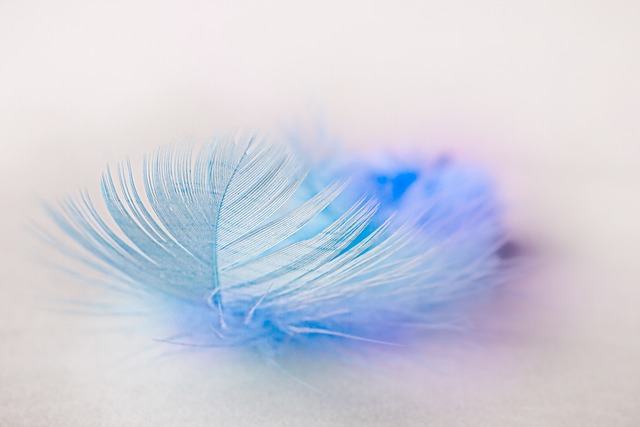A feather can hold religious significance in various cultures and belief systems. It is often associated with spiritual and symbolic meanings, representing different concepts such as communication with the divine, connection to the spiritual realm, or divine guidance. However, it is important to note that the religious symbolism of a feather can vary greatly depending on the specific cultural context and belief system.
Table of Contents
The Symbolic Significance of Feathers in Religious Practices
Feathers have long held a special place in human culture, often being associated with spirituality and religious practices. From ancient civilizations to modern-day rituals, feathers have been used as powerful symbols in various religious traditions. But what is it about these delicate plumes that make them so significant in the realm of spirituality?
One of the reasons feathers are considered religious symbols is their connection to birds. Birds have always been seen as messengers of the divine, bridging the gap between the earthly and the spiritual realms. Their ability to soar high above the ground, seemingly untouched by the constraints of gravity, has led many to believe that they possess a special connection to the heavens.
In Native American cultures, feathers are particularly revered and are often used in religious ceremonies. For many tribes, feathers are seen as gifts from the sky, bestowed upon them by the Great Spirit. Each feather is believed to carry its own unique spiritual meaning, and they are often used as tools for communication with the divine. Feathers are used in smudging rituals, where the smoke from burning herbs is fanned with a feather to cleanse and purify the space. They are also used in prayer rituals, where individuals hold a feather while praying to connect with the spiritual world.
In Christianity, feathers are often associated with angels. The image of an angel with wings is a common depiction in religious art, symbolizing their ability to travel between heaven and earth. Feathers are seen as a representation of the divine presence and protection. In times of distress or uncertainty, finding a feather is often interpreted as a sign that an angel is watching over you, providing comfort and guidance.
Feathers also hold significance in other religious traditions. In Hinduism, the peacock feather is considered sacred and is associated with Lord Krishna. It is believed to symbolize his divine qualities, such as beauty and grace. In ancient Egyptian culture, feathers were associated with Ma’at, the goddess of truth and justice. The weighing of the heart ceremony, where the heart of the deceased is weighed against a feather, was believed to determine the fate of the soul in the afterlife.
Beyond their religious symbolism, feathers also hold a deeper spiritual meaning for many individuals. They are often seen as reminders of loved ones who have passed away, appearing as signs from the other side. Finding a feather in an unexpected place can bring a sense of comfort and connection to those who believe in the power of these symbols.
In conclusion, feathers have a rich and diverse history as religious symbols. Whether it be in Native American ceremonies, Christian beliefs, or other spiritual practices, feathers have been used to connect with the divine and convey messages from the spiritual realm. Their association with birds, angels, and various deities has solidified their place as powerful symbols of spirituality. So, the next time you come across a feather, take a moment to appreciate its symbolic significance and the spiritual connection it may represent.
Exploring the Spiritual Meanings of Feathers in Different Religions

Feathers have long been associated with spirituality and religious symbolism in various cultures and religions around the world. From ancient times to the present day, feathers have held a special place in the hearts and minds of believers. In this article, we will explore the spiritual meanings of feathers in different religions, shedding light on their significance and the beliefs surrounding them.
In Native American cultures, feathers are considered sacred and are often used in rituals and ceremonies. They believe that feathers are gifts from the sky, representing the connection between the physical and spiritual realms. Feathers are seen as a symbol of communication with the divine, and they are used to send prayers and messages to the heavens. Each feather is believed to carry its own unique spiritual meaning, with different colors and types representing different qualities and virtues.
In Christianity, feathers are often associated with angels and divine protection. Many believers see feathers as signs from God or angels, sent to reassure and guide them. Finding a feather in an unexpected place is often interpreted as a message from a loved one who has passed away or as a sign of divine presence. Feathers are also used in religious art and iconography, symbolizing the spiritual realm and the connection between heaven and earth.
In Hinduism, feathers are associated with Lord Krishna, one of the most revered deities. Lord Krishna is often depicted with a peacock feather in his hair, which is believed to represent his divine nature and his ability to attract and captivate others. The peacock feather is seen as a symbol of beauty, grace, and spiritual enlightenment. It is also believed to bring good luck and prosperity to those who possess it.
In ancient Egyptian mythology, feathers were closely linked to the goddess Ma’at, who represented truth, justice, and balance. Ma’at was often depicted with a feather on her head, symbolizing her role in maintaining cosmic order. Feathers were also used in the weighing of the heart ceremony, where the deceased’s heart was weighed against a feather to determine their fate in the afterlife. If the heart was lighter than the feather, it meant that the person had lived a virtuous life and would be granted eternal life.
In Buddhism, feathers are seen as a symbol of enlightenment and spiritual awakening. The peacock feather, in particular, is highly regarded and is often used in Buddhist art and rituals. It is believed to represent the transformation of negative emotions into wisdom and compassion. Feathers are also used in meditation practices, where they are used as a focal point to help calm the mind and connect with the spiritual realm.
In conclusion, feathers hold deep spiritual meanings in various religions and cultures. They are seen as symbols of communication with the divine, divine protection, beauty, enlightenment, and cosmic order. Whether it is the Native American belief in the sacredness of feathers, the Christian interpretation of feathers as signs from God, or the Hindu association of feathers with Lord Krishna, feathers continue to play a significant role in religious symbolism. So, the next time you come across a feather, take a moment to reflect on its spiritual significance and the beliefs it represents.
Feathers as Sacred Objects: Their Role in Rituals and Ceremonies
Feathers have long held a special place in the hearts and minds of people across different cultures and religions. These delicate and beautiful objects have been used as symbols in various rituals and ceremonies, making them an integral part of religious practices. From Native American traditions to ancient Egyptian beliefs, feathers have played a significant role in connecting individuals to the divine.
In Native American cultures, feathers are considered sacred objects that hold deep spiritual meaning. They are often used in ceremonies and rituals to connect with the spirit world and seek guidance from ancestors. Feathers are believed to carry the energy of the bird they came from, and each bird has its own unique symbolism. For example, an eagle feather is highly revered and represents strength, courage, and wisdom. It is often used in important ceremonies and given as a sign of honor and respect.
Similarly, in ancient Egyptian mythology, feathers were associated with the goddess Ma’at, who represented truth, justice, and balance. Ma’at was often depicted with a feather on her head, symbolizing her role in maintaining order in the universe. Feathers were also used in the weighing of the heart ceremony, where the deceased’s heart was weighed against a feather to determine their fate in the afterlife. If the heart was lighter than the feather, it meant the person had lived a virtuous life and would be granted eternal life.
Feathers are not only significant in indigenous cultures and ancient civilizations but also in modern-day religions. In Christianity, for instance, feathers are often seen as a symbol of divine intervention and protection. Many believers interpret finding a feather as a sign that an angel is watching over them or that God is sending them a message. Feathers are also used in religious art and iconography to represent the presence of angels or the Holy Spirit.
In addition to their religious symbolism, feathers have also been used as decorative elements in various ceremonies and rituals. In some cultures, individuals wear feathers as headdresses or adornments during dances and celebrations. These feathers are often brightly colored and serve as a visual representation of the spiritual connection between the individual and the divine. They can also be used to honor specific deities or to mark important milestones in a person’s spiritual journey.
It is important to note that while feathers hold great significance in many religious traditions, their meaning can vary from culture to culture and even from individual to individual. What may be considered a sacred symbol in one religion may not hold the same meaning in another. Therefore, it is essential to approach the topic of feathers as religious symbols with respect and an open mind, recognizing the diversity of beliefs and practices that exist.
In conclusion, feathers have long been regarded as sacred objects in various religious traditions. They are used in rituals and ceremonies to connect individuals with the divine and carry deep spiritual meaning. Whether it is the Native American reverence for eagle feathers, the ancient Egyptian association with the goddess Ma’at, or the Christian belief in angelic presence, feathers continue to play a significant role in religious practices around the world. Their beauty and symbolism serve as a reminder of the spiritual connections that exist beyond the physical realm.
The Cultural and Religious Symbolism of Feathers Across the World
Feathers have long held a special place in human culture and spirituality. Across the world, these delicate and beautiful objects have been imbued with deep symbolic meaning. From ancient civilizations to modern religious practices, feathers have been used as powerful symbols of spirituality, divinity, and connection to the divine.
In many indigenous cultures, feathers are seen as sacred objects that connect humans to the spiritual realm. Native American tribes, for example, have a rich tradition of using feathers in their religious ceremonies. Feathers are often seen as gifts from the sky, representing the connection between the earthly and the divine. They are believed to carry prayers to the heavens and serve as a bridge between the physical and spiritual worlds.
In addition to their spiritual significance, feathers also hold cultural importance in many societies. In ancient Egypt, for instance, feathers were associated with the goddess Ma’at, who represented truth, justice, and balance. The feather of Ma’at was used as a symbol of the pharaoh’s divine authority and was often depicted in hieroglyphs and artwork.
Feathers have also played a significant role in Christianity. In the Bible, feathers are mentioned as a metaphor for God’s protection and care. In Psalm 91, it is written, “He will cover you with his feathers, and under his wings you will find refuge.” This imagery of feathers as a shelter and source of comfort has resonated with believers for centuries.
Furthermore, feathers have been used as religious symbols in various other faiths as well. In Hinduism, the peacock feather is associated with Lord Krishna, a deity known for his divine love and compassion. The peacock feather is seen as a representation of Krishna’s beauty and grace. In Buddhism, feathers are often used as offerings in temples and monasteries, symbolizing purity and enlightenment.
Beyond their religious and cultural significance, feathers have also been used as symbols of personal and spiritual growth. Many people believe that finding a feather is a sign from the universe or a loved one who has passed away. It is seen as a message of guidance, protection, and support. Feathers are often kept as talismans or displayed as reminders of these spiritual connections.
In recent years, feathers have also gained popularity as fashion accessories and decorative elements. However, it is important to approach the use of feathers with respect and understanding of their cultural and religious significance. Appropriation of sacred symbols can be offensive and disrespectful to the cultures that hold them dear.
In conclusion, feathers hold a deep and diverse symbolism across cultures and religions. They are seen as sacred objects, connecting humans to the divine and serving as symbols of spirituality, protection, and guidance. Whether used in religious ceremonies, depicted in ancient artwork, or found as personal talismans, feathers continue to captivate our imagination and remind us of the profound connections between the physical and spiritual realms.
Conclusion
In conclusion, a feather can be considered a religious symbol in certain cultures and belief systems.
For licensing reasons, we must provide the following notice: This content was created in part with the help of an AI.


